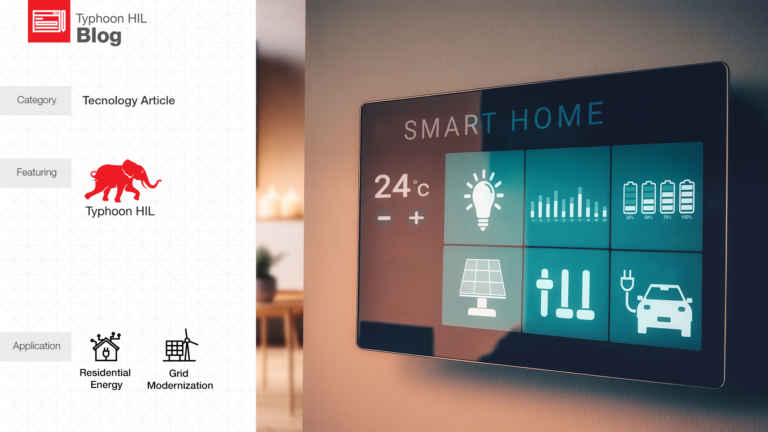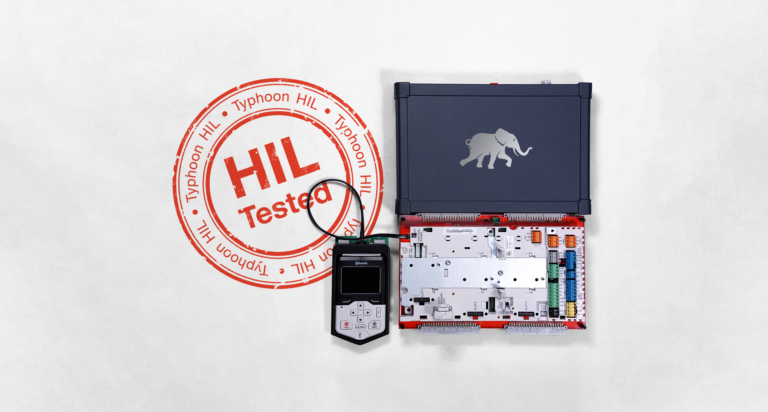Blog

Digital Twins in Power Electronics: Bridging Physical Systems and Virtual Models for Smarter Projects
September 3, 2025
Discover how Digital Twin technology, combined with Typhoon HIL real-time simulators, is transforming power electronics with high-fidelity modeling, real-time validation, and predictive maintenance. From electric vehicles to renewables and smart grids, this approach boosts efficiency, reliability, and adaptability in energy systems. Learn more in our latest blog.

How Smart Buildings Drive Energy Efficiency and Sustainability in Modern Communities
January 30, 2025
Smart buildings are revolutionizing the way we approach energy efficiency and sustainability. By combining passive design with intelligent control systems, these structures optimize energy use, integrate renewable sources, and may even produce and share energy within community microgrids. As electricity consumption in building operations represents nearly 55% of global electricity consumption, smart energy …

Mastering Microgrid Control Testing: Innovations for a Sustainable Future
December 13, 2024
Microgrids and distributed energy resources are critical to a sustainable energy future, but their complexity demands advanced control strategies and rigorous testing. Explore how cutting-edge HIL simulation tools and hybrid control approaches are simplifying microgrid management, improving stability, and enabling seamless integration of renewable energy sources for a greener tomorrow. Read the full blog to…

Testing Digital Substations: Advancements with Hardware-in-the-Loop Technology
September 4, 2024
Advancements in Hardware-in-the-Loop (HIL) technology are revolutionizing the testing and lifecycle maintenance of digital substations, offering significant improvements in efficiency, reliability, and safety. By integrating real-time simulation with substation components, HIL systems enable comprehensive testing of protection schemes, effective and safe training for engineers, and seamless integration with…

Leveraging HIL Compatible for Safe and Efficient Energy Storage System Deployment
June 13, 2024
In our recent webinar session with IHI Terrasun, we explored how HIL Compatible solutions enhance the reliability and performance of their energy storage projects. They shared how they leverage Hardware-in-the-Loop (HIL) technology to safely and efficiently deploy battery energy storage systems (BESS). Through this blog article, gain valuable knowledge from industry experts and discover how innovative HIL d…

Power System Stability Research with HIL at the University of Trieste
March 25, 2024
This blog article explores the research of Prof. Daniele Bosich from the University of Trieste in Italy, focusing on his group’s work on DC system stability using Hardware-in-the-Loop (HIL) simulation. It delves into the challenges, solutions, and advantages of using Typhoon HIL for research, education, and industry collaboration in power systems.

IHI Terrasun uses Typhoon HIL to Deploy Energy Storage Systems Safely and Efficiently
January 17, 2024
In this blog article, learn how IHI Terrasun, a battery and inverter agnostic battery energy storage system (BESS) integrator, uses Typhoon HIL’s C-HIL solutions to test and ensure seamless integration of their energy storage systems before deployment. This proactive testing minimizes risks, accelerates commissioning, and ensures consistency, boosting customer confidence and project efficiency. Furthermore,…

Revolutionizing Ships and Ports: The Rise of Renewable Microgrids
February 22, 2023
In recent years, there has been a growing emphasis on making marine power systems more energy efficient and green. One way to achieve this is through hardware-in-the-loop (HIL) testing, a technique that allows engineers to validate control algorithms for optimization of efficient energy use and that supports the integration of various distributed energy resources (DERs) into a well-functioning whole. Read t…

Industry-Academia Collaboration Brings e-Mobility to the Skies
April 7, 2022
H55 and HES-SO leveraged Hardware-in-the-Loop (HIL) solutions to pioneer clean aviation technology and make aviation history. By utilizing HIL real-time simulators, power electronics engineers can manage increased complexity and accelerate the development of new products. Additionally, these simulators serve as invaluable tools for pilot and engineer training, student education, and facilitating technology…

H55 is Revolutionizing the Aviation Industry with HIL
February 28, 2022
Discover the latest technologies for cleaner air transport as lead partners from H55 share insights on how embracing the unexpected is crucial for achieving a greener future. Learn about the key benefits of using Hardware-in-the-Loop (HIL) in aircraft engineering, and how it plays a vital role in developing more sustainable aviation solutions.

4 Lessons Learned from the Otis Microgrid Project
June 8, 2021
The Otis Air National Guard Base Microgrid Project showcases how strategic integration of new and existing energy technologies can significantly enhance power reliability and energy security. By incorporating Typhoon HIL’s Controller Hardware-in-the-Loop (C-HIL) solution, Raytheon Technologies successfully designed and tested a microgrid control system that not only supports critical real-time missions bu…

Testing Strategies for Building Decentralized Grids
December 9, 2020
As energy networks become increasingly decentralized, driven by advancements in Industry 4.0, Distributed Energy Resources (DERs), and electric vehicles (EVs), the need for robust local control and storage systems is more critical than ever. Hardware-in-the-Loop (HIL) technology is revolutionizing power electronics testing, enabling real-time, high-fidelity validation of new devices at a fraction of the cos…

The Ship is a Microgrid Part II: Why is This so Hard to Design and Build?
June 24, 2019
This is an extension of our previous blog relating a ship’s power system to a microgrid – interconnected loads (propulsion, C4ISR, propulsion, and auxiliary) and distributed energy resources (power generation, distribution, and energy storage) acting as a controllable entity. We will be describing a layman’s perspective on digital engineering as it applies to microgrid design, building, commissioning, ope…

4 Ways Controller Hardware in the Loop and Model-Based Engineering are Reducing Risk
May 21, 2019
As Industry 4.0 dawns, digitalization, decarbonization, and decentralization (D3) are driving the electric grid revolution, creating opportunities and challenges. The emerging cyber-physical grid, with its distributed energy resources, intelligent sensors, and cloud software, requires new design, testing, deployment, and lifecycle maintenance tools. Through several examples, we demonstrate the utility of Ty…

7 Reasons Why HIL Tested is Becoming Ubiquitous
December 6, 2018
The rapid digital transformation of the energy sector, driven by the Fourth Industrial Revolution, is ushering in a new era of complexity and risk. As the grid evolves into a cyber-physical system, rigorous testing becomes paramount to ensure reliability, safety, and security. HIL Testing emerges as a critical methodology in this landscape, offering a systematic approach to validate software and firmware be…

The Ship is a Microgrid Part I: Why is This so Hard to Design and Build?
August 8, 2017
In the realm of naval and merchant marine ships, the concept of a ship as a microgrid—comprising interconnected loads and distributed energy resources—has gained significant importance due to increasing electrification and computerized control. The complexity of power electronic design at both the component and system levels is magnified by multi-physics interactions and the long service life of these v…

Continuous Integration with HIL: Fully Automate Power Electronics Control Software Testing
December 16, 2016
Continuous Integration (CI) is a widely adopted software development practice where developers frequently integrate code into a shared repository, allowing for automatic builds and tests to catch errors early. However, this approach was traditionally unfeasible for power electronics software due to the high cost and slow pace of lab testing required for daily software commits. The advent of ultra-high fidel…

Simplify Microgrid Control Design, Testing, and Commissioning
June 21, 2016
Microgrids, though they date back to the era of Thomas Edison’s DC microgrids, have evolved significantly, driven by the quest for sustainable and resilient power systems. Today, microgrids are characterized by their ability to integrate renewable energy sources and advanced power electronics converters. They can be classified into three main types: customer microgrids, utility distribution microgrids, and …

Flight Simulator for Power Electronics and Power Systems
May 17, 2016
Today’s aspiring electrical engineers have the unique advantage of learning power electronics and power systems hands-on with ultra-high fidelity real-time simulators. These advanced “flight simulators” for power, with their nanosecond resolution and microsecond integration time steps, allow students to interact with smart inverters, distributed energy resources (DERs), microgrids, and power systems with ex…
{{text}}